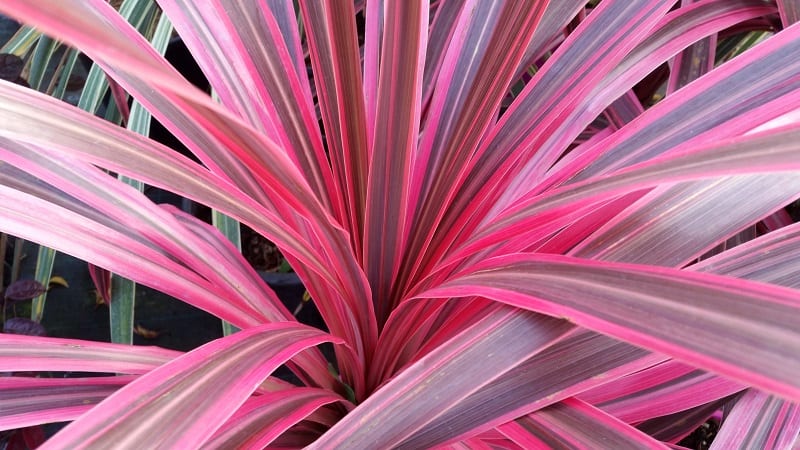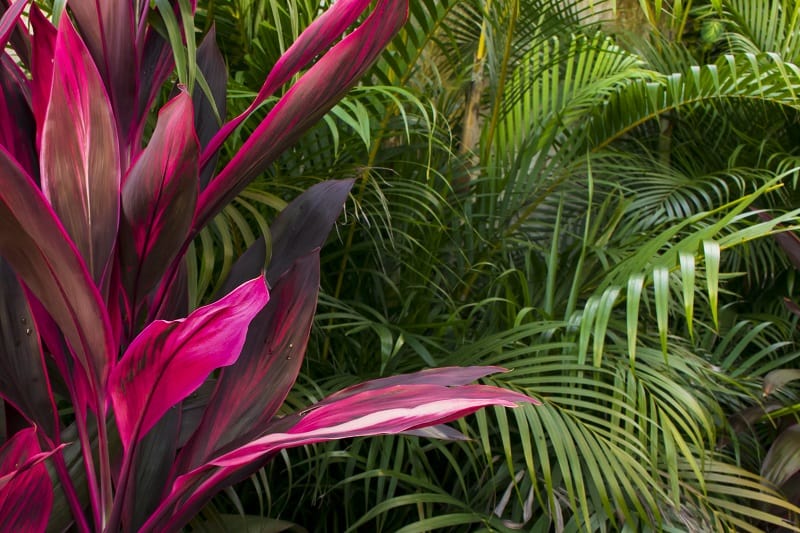Growing Cordyline: Tips for Bright Light Conditions and Care
Cordyline or ti plant is tropical foliage that stands out in any garden or indoors. It has large leaves ranging in color from deep red, purple, green, and variegated pink depending on the variety. The plant originates from tropical climates of Hawaii and other Pacific Islands, parts of Asia, and Guinea. In areas with cooler temperatures, it’s best to place it indoors.
As a houseplant, cordyline thrives best in bright light conditions. When outside in your garden, make sure it gets bright light and adequate wind protection. The plant can grow well in dry and poor soil conditions but greatly appreciates good, rich, well-draining soil inside or outside.
If you’re wondering whether your cordyline prefers sun or shade, read below to learn more.

Ideal Light Conditions For A Cordyline
Cordyline prefers bright light conditions. Even if it can work out with limited shade, the ideal setting is an area in your yard that receives abundant sunlight throughout the day.
When growing cordyline outdoors in your garden or yard, select an area that receives a minimal amount of shade. In case you decide on growing one indoors, choose a site close to the window or a greenhouse that gets plenty of sunlight.
Remember, though, that although cordyline loves bright and sunny conditions, don’t place it in a spot that receives direct sunlight. When left exposed to such situations, the vibrant colors of the leaves will eventually fade.
There are several reputable sources of lovely plants, including FloraFolia, if you are eager to bring one home. You might be able to find cordyline along with other ideal plants to become part of the garden or your indoor space.
Indoor and Outdoor Care for a Cordyline
Besides the ideal light conditions for your cordyline, it would be best to match it with other vital care factors to ensure proper growth.
Outdoor Care
Make sure that you will provide your cordyline with evenly moist soil and partial shade to full sun. Exposure to bright light will bring out the most colorful colors in your plant.
When watering your plant, provide around an inch of water weekly if rain is absent for a long time since cordyline naturally grows in regions with high rainfall levels. Although the plant is moderately tolerant to drought conditions, don’t allow the soil to turn excessively dry since it can cause the leaf tips to turn brown.
Water the plant using a hose to keep the foliage dry. When using a sprinkler, it’s best to water early in the day to allow the foliage to dry up before evening. If the foliage is damp and complemented by cooler temperatures during the nighttime, it puts your plant at risk for fungal issues in the long run.
Fertilize cordyline every other month using balanced granular products. Place around 2 ounces of fertilizer for each plant. Make sure that you will apply fertilizer on damp soil and water right away. Be careful to keep the substance away from the foliage. If it drops on the foliage, rinse thoroughly right away.
If you see old leaves from the plant, you should remove them to keep the plant looking neat and to allow it to form a distinct trunk. You can get rid of the leaves using scissors or garden shears once they turn brown. Avoid pulling out the leaves.

Indoor Care
If you will bring your cordyline indoors, plant it in a potting mix that retains moisture without becoming soggy. A good-quality commercial potting mix is a great choice, or you can prepare one yourself with a mixture of one-part sand, two-parts peat moss, and one-part perlite. Choose a durable pot with a drainage hole in the bottom.
Fertilize your plant using a diluted solution of water-soluble fertilizer. Prepare the mixture at the rate of one teaspoon of fertilizer for each gallon of water. Apply once every month during the spring and summer seasons. An alternative is to use a time-release fertilizer.
When watering your cordyline, do so until water flows out through the drainage hole. Water the plant only when a half inch of the soil is dry to the touch. Leave the pot to drain thoroughly and pour out any leftover water in the drainage saucer.
An alternative mode of watering is to place the pot in a basin of water and allow the soil to absorb the moisture until the soil’s upper level is damp. Depending on the method you use, don’t allow the plant’s bottom to stand in water.
If you keep your cordyline indoors, you should increase the humidity using a pebble bed. Place a layer of stones or gravel in a shallow basin or tray and position the pot on the pebbles. Don’t forget to place a small amount of water on the stones and make sure that they stay damp at all times. Avoid adding too much water that the base of the pot stands in water.
Conclusion
Knowing the light requirements of cordyline will ensure proper growth of the plant and maintain its vibrant leaves. Aside from providing the appropriate light conditions, don’t overlook the other vital care factors to keep your plant happy and healthy at all times.
